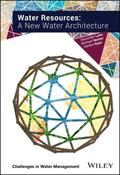Water Resources
A New Water Architecture
Challenges in Water Management Series

1. Auflage September 2017
360 Seiten, Hardcover
Wiley & Sons Ltd
Over 7 billion people demand water from resources that the changing climate is making more and more difficult to harness. Water scarcity and shortage are increasingly common and conditions are becoming more extreme. Inadequate and inappropriate management of water is already taking its toll on the environment and on the quality of life of millions of people. Modern water professionals have a duty to develop sound water science and robust evidence to lobby and influence national and regional development policy and investment priorities. We need to be bold and brave to challenge the status quo, argue the case for change, and create a New Water Architecture.
Water Resources: A New Water Architecture takes a unique approach to the challenges of water management. The stress caused by our desire to live, eat, and consume is examined in the context of Governance, the role of policy, and the commercial world. The authors share their nine-step vision for a New Water Architecture.
Written by three industry practitioners, this book provides students, young professionals, policymakers, and those interested in the sustainability of our natural resources with a pragmatic and compelling perspective on how to manage the ultimate resource of our time.
1. Water Resources in the 21st Century
2. Fundamentals of Water Management
Part 2: Stresses & Strains
3. Introduction and Key Concepts
4. Live
5. Eat
6. Consume
Part 3: Existing Water Architecture
7. Existing Management of Water Resources
8. Ownership and Investment
Part 4: Moving to a New Water Architecture
9. Challenges and Opportunities
10. Conceptual Integration
11. Institutional Integration
12. Physical Integration
13. A Way Forward
Alexander Lane specialises in the development of water strategy and planning that acknowledges the interrelationships between water, other natural resources and human interests. As a consultant in the UK and Australia, Alex has advised a diverse range of public bodies and global companies on the preparation and implementation of robust and sustainable approaches to the management of water that deliver not just immediate gains, but also long-term and mutually beneficial outcomes.
Michael Norton is an expert in water engineering and management, has contributed to
over 100 studies and projects in 20 countries, and was awarded an MBE for his outstanding services to water and international trade. With experience in Europe, Latin America, the Middle East and Asia, Michael's technical interests include water security, water footprint,
sustainable wastewater treatment, urban drainage and the water-food-energy system. He now
provides consultancy to private sector, public sector, government and non-government organisations on a regional, national and international scale.
Sandra Ryan specialises in strategic water resource planning, focusing on finding traditional and alternative solutions in situations where demand for water exceeds the resource available for supply. With a career background in water utility based water resource planning and regulation in the UK, Sandra is transferring these technical principles to clients in the industrial and commercial sectors battling water risks, and national and local governments seeking to build resilience.


